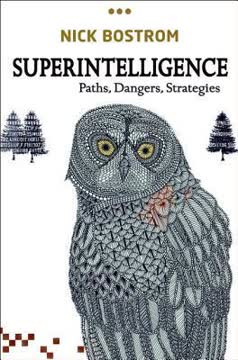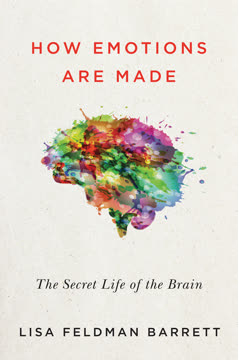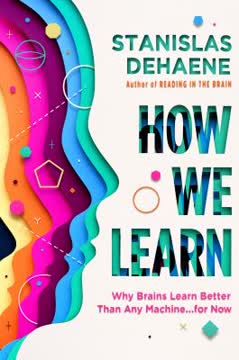Key Takeaways
1. Uncertainty is the Brain's Operating System
The human brain is in fact an exquisite uncertainty-tracking machine.
Inverse Problems. Our brains are constantly solving inverse problems, making best guesses about the world from noisy sensory data. Like Stanislav Petrov, who had to decide whether a radar blip was a missile or a malfunction, our brains must separate signal from noise. This process is fundamental to perception, as our senses provide only limited and imperfect information.
Bayes's Theorem. This mathematical framework helps us understand how the brain combines prior beliefs with new sensory data, weighting each by their uncertainty. For example, in the dice game, we saw how the brain estimates the probability of a trick die being a 0 or 3 based on the noisy total of three dice. This process is not conscious, but it is a powerful way to make decisions under uncertainty.
Predictive Processing. The brain doesn't just passively receive information; it actively constructs our perception of the world. Higher levels of the brain provide context and expectations, while lower levels process sensory data. This constant loop of feedback and feedforward allows us to make sense of the world, even when our senses are limited.
2. Self-Monitoring: The Brain's Internal Autopilot
The most effective way of controlling a system is to develop an accurate model of that same system.
Predictive Control. Our brains use forward models to predict the consequences of our actions and correct deviations. Like a thermostat that anticipates temperature changes, our motor system makes constant adjustments to keep our movements on track. This process is often unconscious, allowing us to perform complex tasks smoothly.
Error Detection. The brain has a rapid error-detection system, as evidenced by the error-related negativity (ERN) brain wave. This "Oh shit!" response occurs milliseconds after an error, allowing us to quickly correct our actions. Dopamine plays a key role in tracking prediction errors, signaling the difference between what we expected and what actually happened.
Multiple Levels of Control. Action control operates at multiple levels, from high-level plans to low-level muscle commands. For example, when typing, we consciously choose the words, but our fingers move automatically to the correct keys. This hierarchical organization allows us to perform complex tasks efficiently.
3. Self-Awareness: A Socially Constructed Mirror
The sorts of things that I can find out about myself are the same as the sorts of things that I can find out about other people, and the methods of finding them out are much the same.
Theory of Mind. The ability to understand that others have minds like our own is crucial for social interaction. This "mindreading" ability develops around the same time as explicit self-awareness, suggesting a shared neural basis. Children who struggle with mindreading also tend to struggle with self-awareness.
Recursive Thinking. Both mindreading and self-awareness involve recursive thinking, such as "I believe that she thinks that I know." This ability to represent multiple perspectives is a uniquely human trait. Language plays a key role in this process, providing the tools for thinking about mental states.
Shared Neural Machinery. Brain imaging studies show that the same regions of the prefrontal cortex are activated when we think about ourselves and when we think about others. This suggests that self-awareness is not an isolated process but is deeply intertwined with our social understanding.
4. Self-Awareness: A Fragile and Evolving Capacity
Being aware of being aware of being. In other words, if I not only know that I am but also know that I know it, then I belong to the human species.
Brain Structure. Humans have unusually large brains for our body size, with a particularly well-developed prefrontal cortex. This region is crucial for self-awareness and is more folded and enlarged in humans than in other primates. The number of neurons in primate brains increases linearly with brain mass, unlike rodents.
Developmental Trajectory. Self-awareness develops gradually throughout childhood and adolescence. It is influenced by our social environment, language, and our understanding of our own bodies. The ability to recognize ourselves in a mirror is an important milestone in this process.
Individual Differences. There are significant differences in self-awareness between individuals. Some people have a more accurate sense of their own abilities and limitations than others. These differences are related to variations in brain structure and function, as well as personality traits and mental health.
5. Metacognitive Illusions: When Self-Awareness Fails
Subjective confidence in a judgment is not a reasoned evaluation of the probability that this judgment is correct.
Fluency. The ease with which information is processed can create illusions of confidence. We tend to feel more confident about decisions that are made quickly or with familiar information, even if they are not more accurate. This can lead to overconfidence and poor decision-making.
Absence of Self-Awareness. Self-awareness is not always present. When tasks become automatic, we may lose conscious awareness of what we are doing. This can be useful for efficiency, but it can also lead to errors if we are not paying attention. Stress and mind-wandering can also cause self-awareness to fade.
Causal Power. Metacognition is not just a passive observer; it has a causal influence on our behavior. By manipulating our feelings of confidence, we can change our decisions and actions, even if our underlying abilities remain the same. This means that metacognitive illusions can have real-world consequences.
6. Metacognition: The Key to Learning How to Learn
To know that one does not know is best; Not to know but to believe that one knows is a disease.
Judgments of Learning. Metacognition plays a crucial role in guiding our learning. We make judgments about how well we know the material and use these judgments to decide what to study next. However, these judgments are often inaccurate, leading us to focus on the wrong things.
Spaced Practice. Spaced practice, where we review material over time, is more effective than massed practice, where we cram everything into one session. However, we often feel more confident after massed practice, even though it is less effective. This is another example of a metacognitive illusion.
Testing Effect. Testing ourselves is more effective for learning than simply rereading our notes. By actively retrieving information, we strengthen our memory and identify areas where we need to improve. Metacognition helps us decide when and how to test ourselves.
7. Metacognition: The Power to Change Your Mind
The real danger, I think, is not that machines more intelligent than we are will usurp our role as captains of our destinies, but that we will overestimate the comprehension of our latest thinking tools, prematurely ceding authority to them far beyond their competence.
Bayesian Updating. A rational Bayesian should be willing to change their mind when presented with new evidence. However, our confidence in our initial beliefs can bias how we process new information. We tend to favor evidence that confirms our existing views and downweight evidence that contradicts them.
Confidence-Weighted Confirmation Bias. The more confident we are in our initial decision, the less likely we are to change our minds, even when presented with contradictory evidence. This bias is modulated by the prefrontal cortex, a region crucial for self-awareness.
Metacognitive Sensitivity. People with better metacognition are more willing to change their minds when they have made an error. This suggests that self-awareness is crucial for flexible and adaptive decision-making.
8. Metacognition: The Foundation of Collaboration
Just as our picture of the physical world is a fantasy constrained by sensory signals, so our picture of the mental world, of our own or of others, is a fantasy constrained by sensory signals about what we, and they, are doing and saying.
Sharing Confidence. When working in teams, we often rely on each other's confidence to make decisions. However, this is only useful if confidence is a reliable marker of accuracy. Metacognition allows us to assess the reliability of our own and others' judgments.
Two Heads Are Better Than One. When people with different perspectives collaborate, they can often achieve better results than individuals working alone. This is because they can pool their knowledge and metacognitive abilities. However, this benefit is only realized when people are able to communicate their confidence effectively.
Eyewitness Testimony. In legal settings, eyewitness confidence is often taken as a sign of accuracy. However, eyewitness confidence is often unreliable, especially after time has passed. This highlights the importance of understanding the limitations of metacognition in social settings.
9. Metacognition: The Basis of Autonomy and Responsibility
The biggest danger, that of losing oneself, can pass off in the world as quietly as if it were nothing; every other loss, an arm, a leg, five dollars, a wife, etc., is bound to be noticed.
Self-Narrative. We construct a narrative about our actions and beliefs, which is crucial for our sense of self. This narrative is not always accurate, but it provides a framework for understanding our behavior. The left hemisphere of the brain plays a key role in interpreting our actions.
Agency and Control. Our sense of agency is a construction, based on our interpretation of our actions. We often feel in control of events that are actually beyond our control. This highlights the importance of metacognition in shaping our sense of autonomy.
Mens Rea. In legal systems, the concept of mens rea (guilty mind) is central to determining responsibility. This concept relies on our ability to be aware of our actions and their consequences. Metacognition is therefore crucial for our notions of autonomy and responsibility.
10. The Future of Self-Awareness: Humans and Machines
You can consider yourself a person of high standards in general and still have debilitating blind spots.
AI and Metacognition. Current AI systems are often intelligent but lack self-awareness. They can perform complex tasks but cannot explain why they are doing what they are doing. This lack of metacognition can lead to overconfidence and errors.
Building Self-Aware Machines. Researchers are exploring ways to build metacognition into machines, such as by creating systems that can track their own uncertainty and monitor their actions. This could lead to more reliable and trustworthy AI.
Human-Machine Collaboration. Another approach is to design human-machine interfaces that leverage human self-awareness. By combining human metacognition with machine intelligence, we can create systems that are both powerful and transparent. This may involve brain-computer interfaces that allow us to monitor and control AI devices more effectively.
Last updated:
FAQ
What's Know Thyself: The Science of Self-Awareness about?
- Focus on Self-Awareness: The book explores self-awareness through metacognition, the ability to think about one's own thinking, and its impact on decision-making and learning.
- Neuroscience Insights: Stephen M. Fleming integrates neuroscience, psychology, and philosophy to explain how our brains support self-awareness, discussing neural circuits and potential failures.
- Practical Applications: It emphasizes cultivating self-awareness in education, decision-making, and collaboration, offering tools to enhance self-awareness and improve life quality.
Why should I read Know Thyself: The Science of Self-Awareness?
- Understanding Yourself: The book provides a scientific basis for self-awareness, crucial for better decision-making and personal growth.
- Research-Based Insights: It presents findings from metacognitive neuroscience, making complex ideas accessible and offering insights into brain function regarding self-awareness.
- Practical Strategies: Readers receive advice on cultivating self-awareness to enhance learning and interpersonal relationships, encouraging reflection on thought processes.
What are the key takeaways of Know Thyself: The Science of Self-Awareness?
- Metacognition is Key: Emphasizes metacognition as essential for effective self-awareness, influencing learning, decision-making, and collaboration.
- Self-Awareness is Fragile: Discusses how self-awareness can fail, leading to overconfidence or lack of insight, and how understanding these failures can prevent judgment pitfalls.
- Cultivating Self-Awareness: Provides strategies like reflective practices and feedback to improve self-awareness, enhancing personal and professional development.
How does Know Thyself define metacognition?
- Thinking About Thinking: Metacognition is the ability to think about one's own thinking processes, involving self-reflection and awareness of cognitive abilities.
- Components of Metacognition: It includes monitoring and regulating one's cognitive processes, recognizing when we know something and when we do not.
- Importance in Learning: Metacognition is crucial for effective learning strategies, helping individuals assess understanding and adjust study methods.
How does Know Thyself explain the neuroscience behind self-awareness?
- Neural Circuits: Discusses brain regions like the prefrontal cortex involved in self-awareness and metacognition, responsible for higher-order thinking and self-reflection.
- Metacognitive Neuroscience: Introduces the field studying how the brain supports self-awareness through neural mechanisms, including effects of brain damage.
- Functional Imaging Studies: References fMRI studies showing brain region activation during self-reflection tasks, illustrating the biological basis of self-awareness.
What are some examples of metacognitive failure discussed in Know Thyself?
- Overconfidence in Decision-Making: Examples of individuals being overconfident in judgments, leading to poor decisions due to unrecognized limitations or uncertainty.
- Anosognosia: Discusses cases where individuals are unaware of cognitive deficits due to brain damage, illustrating compromised self-awareness.
- Everyday Scenarios: Uses relatable scenarios, like students overestimating knowledge before exams, to show metacognitive errors in daily life.
What strategies does Know Thyself suggest for improving self-awareness?
- Reflective Practices: Encourages regular self-reflection through journaling, meditation, or thinking about thoughts and feelings to enhance self-awareness.
- Seeking Feedback: Emphasizes obtaining feedback from others for a clearer perspective on abilities and behaviors, correcting misperceptions.
- Mindfulness Techniques: Suggests mindfulness practices to foster awareness of thoughts and emotions, improving metacognitive skills.
What role does self-awareness play in decision-making, according to Know Thyself?
- Guiding Choices: Self-awareness helps assess knowledge and confidence levels, leading to better decision outcomes in personal and professional contexts.
- Recognizing Errors: Enables recognition of mistakes or flawed judgments, crucial for learning and growth.
- Flexibility in Thinking: Fosters adaptability in decision-making, allowing choices to be adjusted based on new information or changing circumstances.
What are the best quotes from Know Thyself and what do they mean?
- "Nosce te ipsum": Translates to "Know thyself," emphasizing self-awareness's historical importance for personal growth and wisdom.
- "Self-awareness is a fragile, beautiful, and frankly bizarre feature of the human mind": Captures self-awareness's complexity and significance, suggesting its value and vulnerability.
- "The real danger... is that we will overestimate the comprehension of our latest thinking tools": Warns against blindly trusting technology without understanding limitations, underscoring the need for human oversight.
How does Know Thyself relate self-awareness to learning and education?
- Metacognition in Learning: Highlights self-awareness's role in effective learning, helping assess understanding and adjust study strategies.
- Feedback Loops: Discusses how self-awareness creates feedback loops enhancing learning outcomes, allowing performance reflection and approach adaptation.
- Lifelong Learning: Advocates cultivating self-awareness as a lifelong skill, essential for adapting to new challenges and opportunities.
How can I improve my metacognitive skills as suggested in Know Thyself?
- Practice Self-Reflection: Encourages regular self-reflection to assess thought processes and decision-making strategies, through journaling or discussions.
- Seek Feedback: Actively seeking feedback from peers enhances metacognitive awareness, providing valuable perspectives on thought processes.
- Engage in Mindfulness: Suggests mindfulness practices to improve self-awareness and metacognitive skills, fostering better decision-making.
What future directions for self-awareness research does Know Thyself suggest?
- Integration with Technology: Discusses potential integration with AI and brain-computer interfaces to enhance understanding of cognitive processes and decision-making tools.
- Educational Applications: Calls for research on teaching and cultivating self-awareness in educational settings, improving learning outcomes.
- Mental Health Implications: Suggests understanding self-awareness can impact mental health treatment, enhancing metacognitive skills for managing conditions like anxiety and depression.
Review Summary
Know Thyself explores metacognition and self-awareness through a scientific lens. Fleming examines brain function, decision-making, and learning processes, offering insights into human cognition. Readers appreciate the accessible writing style and fascinating research presented. Some found the neuroscience details excessive, while others praised the book's thought-provoking nature. Mixed opinions on the AI chapter emerged. Overall, reviewers found the book informative and engaging, despite occasional critiques of writing style or depth. Many readers gained new perspectives on self-awareness and metacognition, recommending it for those interested in understanding human cognition.
Similar Books










Download PDF
Download EPUB
.epub digital book format is ideal for reading ebooks on phones, tablets, and e-readers.




